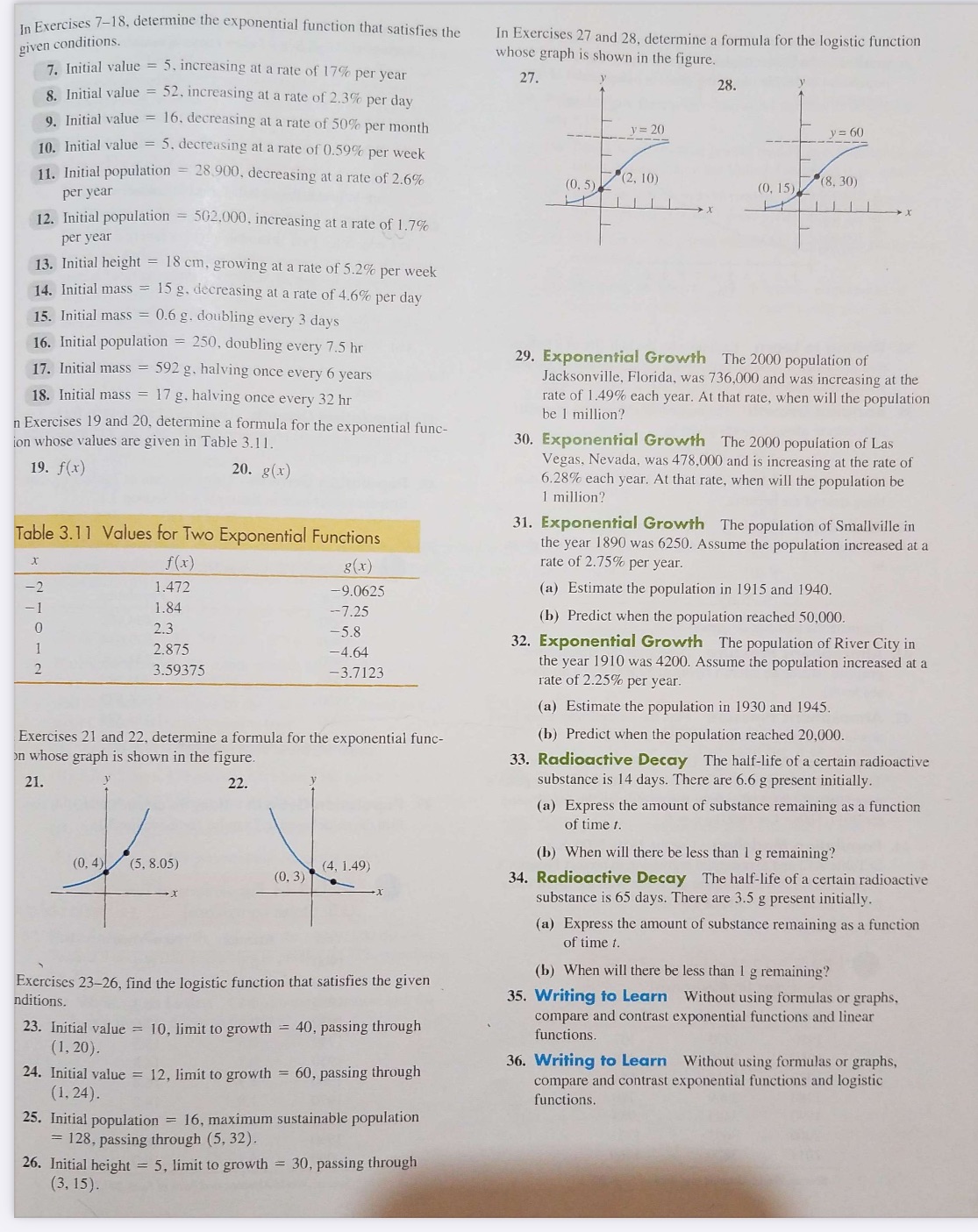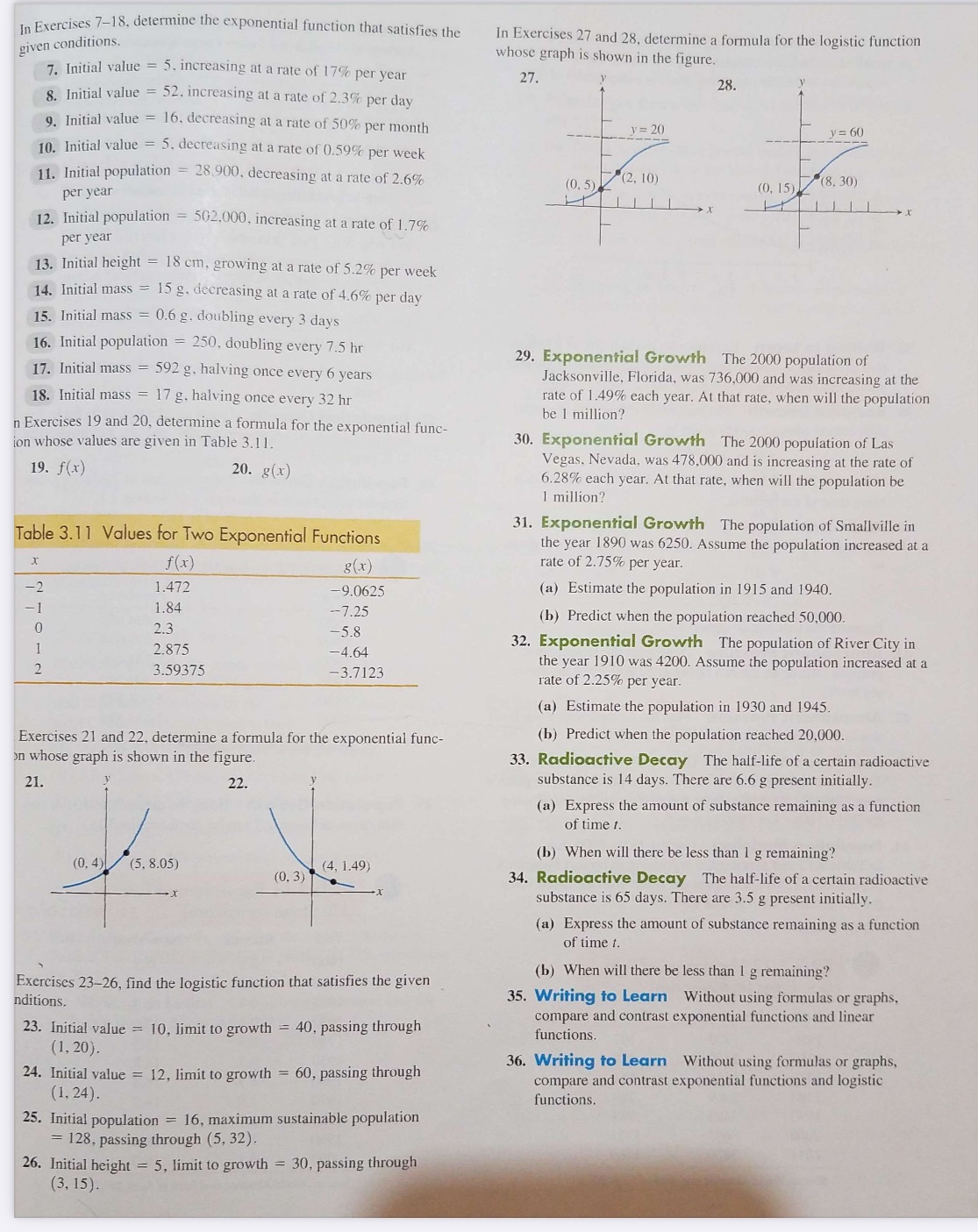
Please help! Just questions 3-21 all and then 33-37 odd. With work
In Exercises 7-18, determine the exponential function that satisfies the In Exercises 27 and 28, determine a formula for the logistic function given conditions . whose graph is shown in the figure. 7. Initial value = 5, increasing at a rate of 17% per year 27. 28. 8. Initial value = 52. increasing at a rate of 2.3% per day 9. Initial value = 16. decreasing at a rate of 50% per month y = 20 y = 60 10. Initial value = 5. decreasing at a rate of 0.59% per week 11. Initial population = 28.900, decreasing at a rate of 2.6% (0. 5) (2, 10) (0, 15) (8, 30) per year - x 12. Initial population = 502,000, increasing at a rate of 1.7% per year 13. Initial height = 18 cm, growing at a rate of 5.2% per week 14. Initial mass = 15 g, decreasing at a rate of 4.6% per day 15. Initial mass = 0.6 g. doubling every 3 days 16. Initial population = 250, doubling every 7.5 hr 29. Exponential Growth The 2000 population of 17. Initial mass = 592 g. halving once every 6 years Jacksonville, Florida, was 736,000 and was increasing at the 18. Initial mass = 17 g, halving once every 32 hr rate of 1.49% each year. At that rate, when will the population be 1 million? n Exercises 19 and 20, determine a formula for the exponential func- ion whose values are given in Table 3.1 1. 30. Exponential Growth The 2000 population of Las 19. f(x) 20. g(x) Vegas, Nevada, was 478,000 and is increasing at the rate of 6.28% each year. At that rate, when will the population be 1 million? 31. Exponential Growth The population of Smallville in Table 3.11 Values for Two Exponential Functions the year 1890 was 6250. Assume the population increased at a x f (x) 8(x) rate of 2.75% per year. 1.472 -9.0625 (a) Estimate the population in 1915 and 1940. 1.84 -7.25 (b) Predict when the population reached 50,000. 2.3 -5.8 2.875 32. Exponential Growth The population of River City in -4.64 the year 1910 was 4200. Assume the population increased at a 3.59375 -3.7123 rate of 2.25% per year. (a) Estimate the population in 1930 and 1945. Exercises 21 and 22, determine a formula for the exponential func- (b) Predict when the population reached 20,000. on whose graph is shown in the figure. 33. Radioactive Decay The half-life of a certain radioactive 21. 22. substance is 14 days. There are 6.6 g present initially. (a) Express the amount of substance remaining as a function of time t. (b) When will there be less than 1 g remaining? (0, 4) (5, 8.05) (4, 1.49) (0. 3) 34. Radioactive Decay The half-life of a certain radioactive substance is 65 days. There are 3.5 g present initially. (a) Express the amount of substance remaining as a function of time t. (b) When will there be less than 1 g remaining? Exercises 23-26, find the logistic function that satisfies the given nditions. 35. Writing to Learn Without using formulas or graphs, compare and contrast exponential functions and linear 23. Initial value = 10, limit to growth = 40, passing through functions. (1, 20). 36. Writing to Learn Without using formulas or graphs, 24. Initial value = 12, limit to growth = 60, passing through compare and contrast exponential functions and logistic (1, 24). functions. 25. Initial population = 16, maximum sustainable population = 128, passing through (5, 32) 26. Initial height = 5, limit to growth = 30, passing through (3, 15 )








